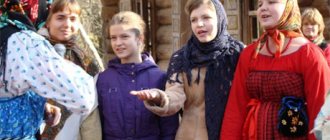An Azerbaijani wedding is perhaps the most important event in the life of every family in the country. In Azerbaijan, marriage is taken very seriously and preparation for the celebration takes a lot of effort and time from both the groom and the bride. The peculiarity of the country’s culture in this matter is that all stages of a couple’s relationship from choosing a bride to engagement have a number of their own unique traditions and characteristics. They are passed down across the country from generation to generation and make the culture unique.
Azerbaijani wedding traditions
From an early age, Azerbaijani girls are taught modesty and the need to stay away from male companies. Despite the freer customs of our time, the right to choose still remains with the man. When choosing a potential bride, a man must ask his parents for permission to marry a specific candidate. In Azerbaijan, the opinion of parents sometimes plays a decisive role in a young man’s choice of a future wife.
If the parents give consent, the young man should, according to tradition, ask his trusted relative to find out more about the potential chosen one. In particular, the groom will be interested in the material wealth and social level of the future bride. This factor influences whether a man will be strong enough to support a girl in the future. You will also learn such nuances as:
- health of the future woman;
- her level of education;
- housekeeping skills.
The only thing that often remains behind a veil of secrecy is age. In this country, engagement is allowed even if the girl is 14 years old.
16+
“I was married off against my will when I was barely sixteen years old,” says my interlocutor Zarema. “That’s what my parents decided, referring to the traditions of the Azerbaijani people, and after twenty years of happy family life, I understand that they were right.”
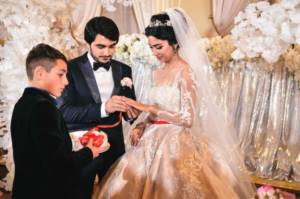
The choice is up to the groom
In Azerbaijan, the right to choose a bride is given to the groom. But the last word remains with his parents. Their opinion was not contradicted twenty, fifty, or a hundred years ago. They don't do this even now. Only after the father and mother, so to speak, make inquiries about the future bride, find out how modestly she behaved, what the financial situation and social status of her family are, do they give consent to their son’s marriage.
“Now in Azerbaijan morals have become freer, but the choice still remains with the man and his parents,” says Zarema. – By the way, people inquire about their financial situation not in order to choose the most profitable party. In this way, the groom determines whether he can support his young wife and family. It is also important that the girl be healthy and, preferably, educated. But they almost never ask about age. An engagement in Azerbaijan is possible even if the bride is only fourteen years old.”
Matchmakers to the house - bride from home
The discussion of the candidacy is submitted to the council of all relatives. And if there is not a single objection, a decision is made to send matchmakers. They do this twice.
First, the mother of the groom and one of his other relatives come to small matchmaking in Azerbaijani style. Afterwards the fathers meet. “The groom’s father comes not alone, but always with three relatives or simply respected people in the area,” says Zarema. – According to custom, the girl’s father must refuse him and tell him that he needs to find out the opinion of the girl herself. This is, of course, a formality. The daughter must remain silent - then it will mean that she has agreed to become a bride.”
The second stage, or, as they also call it, the big matchmaking of the Azerbaijani bride, begins with the head of the groom’s family discussing the upcoming wedding with his relatives. The women of this family go to the bride to set the day for the matchmakers to arrive. By the way, the bride herself is not present at the event; at this time she goes for a walk with her mother. Meanwhile, relatives and matchmakers are talking. “The next visit of the matchmakers looks more festive - they call the guests, set the tables,” says my interlocutor. – The girl’s mother remains at home, but keeps a vow of silence. And the future bride goes to her friend. At this time, the bride's father blesses the couple. The girl returns home only after the matchmakers leave. If a bride cries all evening about her upcoming marriage, this, oddly enough, is a good omen.”
The betrothed will be dreamed of the night after the bachelorette party
Betrothal in Azerbaijan, like matchmaking, also has two stages. Several months should pass between small and large. In the first case, the groom's envoy comes to the bride's house and, in the presence of her many friends, puts a ring on her finger and covers her head with a scarf. Then, having sent the groom a piece of dessert through him, the girls have a bachelorette party. “We don’t have a bachelorette party like they show in comedies,” says Zarema. – The hostess sets a “sweet table”, symbolizing prosperity and happiness in the family. Next, the bride touches the head of her unmarried bridesmaids, and they try on her ring. The first of the friends to try on the jewelry, according to legend, will soon become a bride herself. And in the evening, unmarried women place two identical pieces of sweet pastries under their pillow to see their betrothed in a dream.”
Stay at home, don't go out!
At the second stage of the engagement, a lot of people gather, so they prepare for this day more carefully. The groom's relatives give the bride everything that could be useful, except for shoes - this is the responsibility of the mother-in-law. They definitely do this to the music. Then, having ringed the bride again, the size of the ransom is agreed upon. This money is then spent on the wedding itself and on the dowry. The amount of monetary compensation in case of divorce is immediately indicated. Then the exchange of gifts begins. “Months, and sometimes even years, could pass from engagement to wedding,” says Zarema. “The future bride had to be at home, and the groom’s family would send her everything she needed: clothes, food.”
And a lamb with horns...
Wardrobe items were passed on as family heirlooms by the groom's family to the bride. Great importance was attached to such items as a red scarf, a richly embroidered dress, jewelry, and a lamb with horns painted with henna. “Henna, which is used to paint a girl’s hands and feet and dye her hair before the wedding, is also given by the groom,” continues Zarema’s story about Azerbaijani traditions. – We also always give gifts to the carrier who brings the bride’s personal belongings to the groom’s house. After the move, the girls’ friends come and put things in order in this house, decorate it, by the way, also for gifts.”
The celebration was celebrated, as a rule, in two houses, starting with the bride. The celebration was announced throughout the area by the sounds of the zurna (an ancient musical instrument), and always at noon. Young people responded to these calls and got involved in serving the guests. Only the groom's relatives were allowed to dance with the bride at the wedding. Towards evening, guests from the newly-made husband had to leave this house. Then we celebrated without them. Accompanying the bride to the groom's house, the father kissed her forehead, the mother blessed the girl. The wedding cortege, according to Azerbaijani traditions, headed to the guy's house, driving recklessly along the road, honking and even firing rifles to announce the happy event to a larger number of people.
To make life sweet
When the cortege arrives at the place, a ram is slaughtered, and a drop of its blood is applied by the groom's mother to the foreheads of the newlyweds. Then the groom sprinkles rice, sugar, coins, sweets and sweet cakes on the bride's head. This, according to Azerbaijani beliefs, will certainly bring good luck, prosperity and success to the young family. “We were blessed in the same way,” recalls Zarema. - We followed all the customs. My husband and I have four children – three sons and a daughter. Now the eldest is getting ready to get married. Therefore, we contact relatives, discuss all the details so as not to miss or forget anything. True, today some traditions are no longer relevant. For example, my mother always wore a red dress when she got married. And I'm already in white. Many mixed marriages have appeared, interethnic ones. That’s why celebrations are held, taking some things into account and rejecting others. I adhere more to folk traditions. I am sure that our ancestors knew the secrets of a long and happy life.”
Tatiana KOZAR
Photo from RuNet
Main stages of matchmaking
After choosing a bride, the groom’s side sends relatives to the young woman’s house. With the consent of both parties, matchmaking will soon take place. The nuance of this ritual is that it is usually carried out in several stages, namely two. The first is called Small, the second - Big.
The first stage begins with the groom's father talking with the older generation of the bride. During the conversation, the opinion of each family member is listened to. Next, the matchmakers are sent directly to the girl’s house. Small matchmaking takes place in the presence of the groom's mother and a couple of other relatives as witnesses.
After this ceremony, the fathers of the two parties meet. The groom's father usually comes accompanied by three men. These can be both relatives and other significant people in the environment. It is he who reports on his son’s desire to marry the daughter of the other side’s family. The groom's father emphasizes the importance of the bride's opinion regarding marriage. If a girl is silent, this means consent. After which the matchmakers are removed.
The beginning of the Grand Stage is marked by a discussion by the head of the groom's family of the upcoming celebration and its details. Women from the young man’s side of the family again go to the bride and find out her opinion. If everything is in force, the day of arrival of the matchmakers is set. At the appointed time, matchmakers arrive and are given a place of honor in the house during the feast, usually at the head of the table. The bride is usually absent from the celebration, devoting time to communicating with her mother. If the conversation with relatives is a success, then the matchmakers take time to think about the details of the celebration.
During the second visit of the matchmakers to the bride's relatives, the matter takes place more solemnly. The table is set, a party is organized with a massive arrival of guests. The bride's mother should stay at home, but now her opinion should not be voiced, she should be silent. Ladies usually spend time visiting friends away from the hustle and bustle. After which, with mutual consent, the bride's father must bless the couple. And during the tea party, one of the girl’s friends should have time to run to her with congratulations and news.
The bride returns to the house after the festivities and the main part of the celebration are over. In Azerbaijan, the bride's crying on this day is considered a positive sign of a happy future.
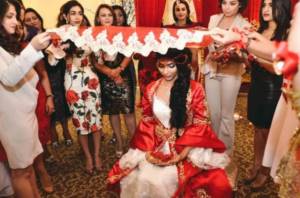
Matchmaking
The groom usually chooses his own bride, and the parents already approve or disapprove of his choice based on the facts collected about the girl. Usually this is done by a female from the groom’s family, for example, his older sister, who finds out how rich the bride’s parents are, what their status is in society, etc.
If the bride suits the groom, his mother and a close relative go to the newlywed’s house for small matchmaking (as in Kazakh wedding traditions). The bride's family does not immediately give a positive answer, but reserves the right to think.
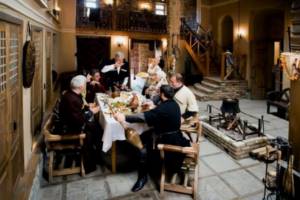
After visiting the bride’s house, the groom’s father and relatives gather for a council to decide on a big matchmaking, which is carried out as follows. On the appointed day, the groom's father and three respected members of their family go to the girl's house. After discussing general topics, the matchmakers start talking about the wedding, but even if the bride’s family is ready to marry her off, the father does not give a positive answer, but sets another day for the matchmakers. On this day, the bride's family prepares a table for the matchmakers, who are only now receiving a positive answer.
During matchmaking, as in the case of the same ritual at a gypsy wedding, the bride should not be present at home, but stays with a friend awaiting the decision of both families. When the decision is made, her sisters and relatives come for her and accompany her to her home, where she receives congratulations. The long ceremony of matchmaking in Azerbaijan is coming to an end!
Preparation for engagement and ceremony
Despite the displacement of a number of traditions, betrothal remains a ritual that has not changed in the country even after several hundred years. Like matchmaking, the betrothal ceremony includes two main stages.
The stage of the Small Betrothal begins after the groom's side receives the consent of the bride's parents for the marriage. Usually it does not take more than a month. To do this, relatives from the groom’s side must come to the young bride’s house. The lady at this time should be accompanied by a large number of friends.
The task of one of the ambassadors is engagement, that is, he must put a ring on the bride’s finger and cover her head with a special scarf. After which he is offered to eat a sweet, of which he must bite off half. The second, according to tradition, is delivered by the ambassador to the groom after the ritual is performed.
After the ambassadors leave, the housewives must set a sweet table, symbolizing the happiness and prosperity of the young family. The bride must then perform the bridal shower ceremony. She touches her hand to the head of each friend, and she, in turn, must try on her wedding ring. According to the superstition, the first one whose head the bride touches will soon get married. You can also see your betrothed thanks to a simple ritual: you had to put some sweet pastries under the pillow.
The Big Betrothal stage in the country begins a few months after the first, Small stage. Preparations for the event include preparing a sumptuous table and the help of relatives from the groom is not excluded. At this stage, it is customary to invite many guests, and not only relatives, but also neighbors, as well as distant friends.
The groom's friends gave gifts to the young bride, mainly those that could be useful to her in her new family. Only shoes were usually not given as a gift, since a little later this ritual was performed by the mother-in-law. Smaller gifts were placed on a special tray, which was covered with a special colorful cloth. Often the offering of gifts was accompanied by music. After which the ring was put back on the girl’s finger, and then a discussion followed about the size of the possible ransom. The money raised after the ceremony was spent on wedding preparations and the formation of a dowry.
A wedding in Azerbaijan requires the existence of a certain agreement if both families wish. According to it, the bride is entitled to an agreed amount of money in the event of a divorce from her husband in the future. From the engagement stage to the wedding celebration itself, it could take either a couple of months or several years. At the same time, the bride sat at home while waiting, and the groom’s relatives had to give her various necessary gifts, ranging from clothes to fruits. On the day of sacrifice, a bull was considered an ideal gift.
After the Big Betrothal stage, gifts to the groom's family must be given by the other party. The trick is to send gifts on the same trays on which the young woman previously received gifts. Gifts are distributed as follows.
- The first gift is intended for the groom himself.
- The second one is sent for men of the family circle.
- The third is for the ladies of the groom's family.
Other trays are designed to be filled with sweets and other nice little things. Now the responsibilities for collecting the festive table lie on the other side. But in this case the number of guests is expected to be smaller.
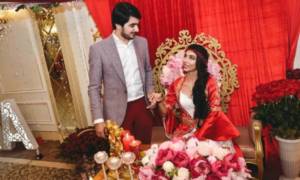
Engagement ceremony
The groom's first visit to the bride's house
The betrothal ceremony of the newlyweds takes place a few days after consent is received. The groom's relatives come to the bride's house; as a rule, there are from 6 to 10 of them. The girl is presented with a ring, several outfits and a scarf. During the engagement, the groom's brother, or his close relative, puts a ring on the bride's finger, on which the names of the bride and groom are engraved. At the same time, he always says: “I give you this ring of fate, love each other, have boys and girls.”
Some families practice a slightly different ritual, when on the day of engagement, traditional Azerbaijani sweets, meat or other products are sent to the bride’s house from the groom’s house. On this day, the bride is presented with a ring, expensive clothes and a headscarf. According to tradition, a happily married woman shows the gifts she has brought to guests, so that the bride will experience only happiness in her new family life. After the engagement, the groom is also given a ring. This stage of the engagement is called the groom's first visit to the bride's house.
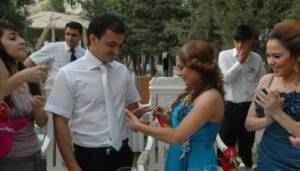
During the engagement, the groom's brother, or his close relative, puts a ring on the bride's finger, on which the names of the bride and groom are engraved
Meeting relatives
The next stage of engagement is the introduction of relatives. These days, the groom's relatives present the bride with various gifts and praise her intelligence and beauty. During the same period, the bride’s relatives, with gifts and sweets for the groom’s family, along with their close relatives, go on a return visit to the newlywed’s house. Relatives of the newlyweds arrange a joint celebration.
Concentration
After the introduction ceremony, the relatives jointly decide what the number of guests invited to the wedding will be, what kind of food will be on the wedding table, and the day is set for the ceremony of presenting and demonstrating gifts for the bride and, in fact, the wedding day itself. This stage of engagement is called concentration.
An official marriage is registered in the presence of witnesses from the bride and groom a couple of days before the wedding celebration.
Pre-wedding preparation
In Azerbaijan, special attention is paid to this stage. Since the overall well-being in the future of a young family depends on the quality of its execution. Azerbaijani wedding traditions include an additional pre-wedding conversation between the families of both parties. The final decision on the formation of the wedding, down to the musical accompaniment and menu, is determined by the men.
In the interim period, other rituals related to the wedding are also carried out. It is interesting that the tradition of presenting gifts to the bride from the groom has been firmly preserved to the present day. In addition to other wardrobe details, a red scarf was considered a constant and important attribute one day. They also gave a rich dress and a lamb, whose horns were decorated with henna.
This tradition preserves the ritual of giving fruits and sweets on special trays, as in the matchmaking stage. Among other things, the bride is usually given henna, with which her hands are beautifully painted and her hair is also dyed.
Before the wedding ceremony, the bride's parents personally transport her personal belongings to the groom's home and also leave her dowry. The groom's mother should then thank the carrier by giving him a special gift. Afterwards, the bride's friends visit the house, clean it up and prepare it for the celebration. After all the events, the future mother-in-law of the bride also thanks them for their work.
A few days before the important ceremony, a ritual called Parcha Bichini is performed. On this day, a mentor is chosen for the future young bride. Another important nuance: the preparation of bread usually began a couple of days before the main celebration.
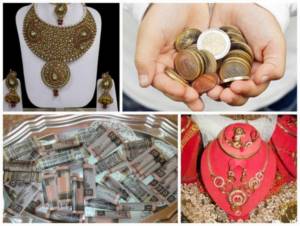
Basic preparations for the wedding
After the engagement, both families gather to discuss all the necessary components of the future ceremony:
- Guest list.
- Menu on the table.
- Music, etc.
Usually, several months pass from engagement to wedding, because everything needs to be carefully planned and prepared. Also during this period, a number of other rituals are carried out, in which the girl is presented with unusual gifts by the groom’s relatives:
- Hand-sewn and embellished dresses.
- Red scarf;
- Decorations;
- Ram with henna-dyed horns.
- Henna dye for applying pre-wedding patterns on hands and feet.
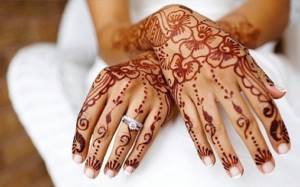
The bride's dowry and belongings are also transported to the groom's house before the wedding. Then the bride's friends come to the groom's house to restore order and decorate the house. The girl’s mother-in-law rewards them for their efforts.
Another unusual ritual is the selection of the bride’s mentor “brocade bichini”, a few days before the wedding.
Bride's farewell ceremony
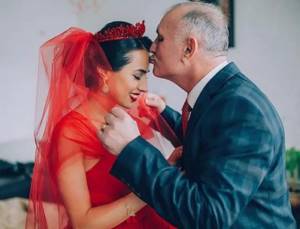
First of all, guests from the groom’s side come and take the bride, accompanying the procession with dancing and singing. The bride herself is waiting in the wings behind closed doors, the keys to which guests will be able to receive immediately after they present the gift to the newlywed’s family. After presenting the gift to her parents, the girl is also blessed by tying a red ribbon around her waist. Next, they cover her head with a veil and take her out into the yard, where an impressive fire should already be lit. The tradition involves circling the bride 3 times around the fire, which symbolizes the future comfort and warmth of the new family. They usually throw a stone after them as a symbol of the fortress of the future home and family. Next comes the turn of water, which is dripped at the girl’s feet. This symbolizes a happy marriage without tears and disappointments.
Next, a plate is placed at the bride’s new house, which she breaks with her foot. Then it is important that the girl is given a male child into her arms. Thus, it is believed that after the ritual the first-born male will be born. Which is very important for Azerbaijani families.
Then, according to tradition, a young ram must be killed in front of the girl. This ritual is designed to help maintain happiness and harmony in marriage, as well as quickly integrate the girl into a new family, avoiding quarrels and disagreements with her husband’s relatives. Another ritual for harmony is the mother-in-law stroking her daughter-in-law’s hair during the wedding. As a sign of abundance, rice and sweets are sprinkled on the bride's head. Afterwards, the young bride is taken to a special decorated room, where she receives congratulations and warm wishes, including from large offspring.
Next, the young couple is sprinkled with rice again for greater financial well-being. In Azerbaijan, a tradition has been preserved, which consists of ransoming the bride, which is asked from the newlyweds on the way to the new house by the bridesmaids and other guests, blocking their way.
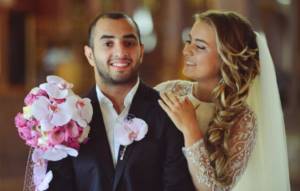
Celebrating a wedding in Azerbaijan
In the evening before the wedding, a henna anointing ceremony is performed in the home of the Azerbaijani bride, in which, according to ancient traditions, female representatives from both families participate. Relatives and girlfriends say goodbye to the newlywed, who will leave their home tomorrow. Another important task of bridesmaids is to decorate the groom's house and prepare it for the new life of the couple. Various furniture, household items, textiles, etc. are usually taken there. And the girls put everything in its place, creating comfort in the house.
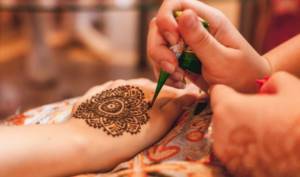
The wedding celebration begins with the groom and his relatives coming to pick up the bride, who leaves the house only after presenting her with a gift from the groom's family. The girl's relatives say goodbye to her and bless her. Her waist is tied with a red ribbon, a scarf is thrown over her head and she is taken out into the courtyard, where, according to Azerbaijani traditions, several symbolic rituals are performed, for example:
- A pebble is thrown after the bride so that the walls of the abandoned house are strong and indestructible.
- A few drops of water are poured under her feet so that in her new home she will not be sad or grieve.
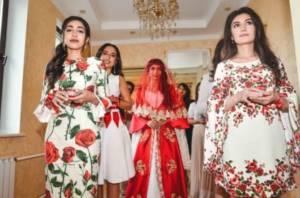
Then the newlyweds and their guests go to the groom’s house, where the guy’s relatives are waiting for them. There are also interesting rituals that have a certain meaning:
- On the threshold of a new house, a plate is placed at the bride’s feet, which she must break with her foot “for good luck.”
- A little boy is placed in her arms so that the first-born in the family will be an heir.
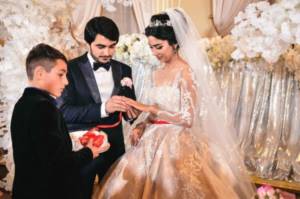
At an Azerbaijani wedding, great attention is paid not only to traditions and customs, but also to national music and dances, without which it is impossible to imagine any celebration in Azerbaijan. Why photos from an Azerbaijani wedding turn out bright and spectacular, you can see for yourself!
What is the “Shah” of the bride
A shah is a special wooden decoration intended for the bride. It usually consists of several elements:
- mirrors;
- fabrics and candles;
- fruits;
- sweets.
Traditionally, the decoration is prepared by the best friend of the hero of the occasion. The girl’s house also hosts festivities and fun that accompanies the entire ritual. Afterwards, in the evening, the groom and his retinue come for the Shah, after which they go to the young woman’s house and give her the jewelry. Accompanying this entire celebration with shots from hunting rifles and songs, as well as dancing.
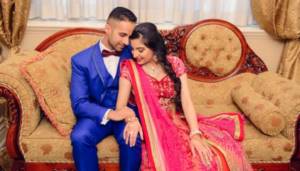
Tradition of a wedding for two houses
According to tradition, the celebration begins at the bride's house. At exactly 12 noon the sounds of the zurna are heard, which symbolize the beginning of the celebration. The younger generation helped the elders in serving the guests, who brought rich gifts in the form of gifts and money. Before accepting the gift, the bride's relatives had to put money in a special place, for the so-called cauldron.
After everyone donated money, it could be opened. Only relatives from the groom's side have the privilege to dance with the bridegroom.
At approximately 5 o'clock in the evening, relatives on the spouse's side must leave the house, and the holiday will continue without their participation.
After the holiday in one house, the celebration continues at the groom's. While the house is being prepared, the groom and his relatives go to pick up his betrothed. Parents do not take part in the procession. Those arriving for the bride are waiting for her at the door of the house. The groom must wait for the girl with the driver while the young mother gives gifts to the waiting guests. After which the groom joins his relatives.
Each relative of the bride must kiss her as a sign of farewell. Usually the last words are spoken by the father, who also kisses her forehead after the speech. It is the mother's responsibility to bless the young one. After the ceremony, the macaw heads to the man's house. In this case, the car with the bride usually travels in front, and the rest of the cortege follows it. Trips of this type usually do not pass without noise. Guests can make noise and fire their rifles, light torches and overtake each other. What sometimes attracts excessive attention from passers-by.
Before arriving at her new home, the bride must remove one shoe. This signal tells new relatives about the imminent arrival of the young woman. After the arrival of the cortege, the bull is slaughtered and its blood is marked on the foreheads of the young people. Afterwards, the groom sprinkles the chosen one’s head with rice, money, sweets and other little things to gain wealth and happiness.
After the bride enters the room, she does not have the opportunity to sit down immediately. The young woman has the right to sit down only after presenting a gift from her mother-in-law or a promise on her part to give it. The celebration is held inside the courtyard, where, according to tradition, those invited from the bride’s side arrive at 6 pm. Parents on the young side are allowed to spend a small amount of time at the holiday, after which they must leave.
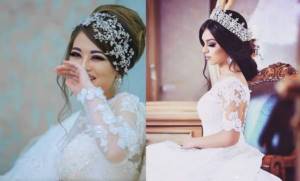
Ceremony of presenting and displaying gifts
During the ceremony of demonstrating the outfits, his relatives come to the groom's house. Together they inspect the gifts for the bride and collect them in special suitcases, which are decorated with red ribbons. On this day, many bouquets are ordered and trays with sweets are decorated to decorate the house. Then all the groom's relatives go to the bride's house.
Gifts for the bride and female relatives
In the bride's house, suitcases are opened and a kind of viewing of things presented as gifts not only to the bride, but also to her mother, grandmother, sisters and brothers is arranged. The main persons at this ceremony are elderly women who act as proxies for the bride and groom. The woman from the bride’s side accompanies the newlywed to the groom’s house, where she cuts a small piece of fabric, which is called “Paltar kesti” (translated as cutting out an outfit), and this piece is subsequently stored in the house of the newlyweds. The woman on the groom’s side presents her “colleague” with money as a payoff.

A gift for the bride can include absolutely everything: from gold rings to scented soap or body cream
Dowry inventory
At this solemn ceremony, it is customary to serve fruits and sweets; lunch consists of several national dishes, such as dolma, bozbash, meatballs and dovga. A separate dinner party is organized for men. After the ceremony, the relatives of the newlyweds draw up an inventory of the bride's dowry, which is then transferred to the groom's house. At the same time, two women go to the newlywed's house to decorate the bride's room.
Wedding advice
After this, the so-called “wedding council” gathers in the groom’s house, at which the relatives decide which of them will be the “wedding grandfather” (Khan-gora), i.e. the person who will lead the wedding, monitor the order and progress of the celebration. Upon completion of the preparatory work, the wedding begins.
Bride's outfit and hairstyle
The bride has a wide variety of wedding dress options, ranging from national dresses, which are richly decorated with stones and embroidery, to a white bride’s dress in the traditions of modern fashion. It is noteworthy that while modern dresses have open sleeves, traditional Azerbaijani versions have closed arms, symbolizing the modesty of the bride. The main details of the image are the veil and red ribbon, which, as mentioned above, is traditionally belted around the waist.
Traditional hairstyles for both the bride and the girls present at the celebration deserve special attention. The abundance of options is complemented by the natural beauty and thickness of Azerbaijani hair. The main task of a hairdresser is to emphasize the natural beauty of hair with the help of a well-chosen hairstyle. In rare cases, the bride’s hair is completely hidden with a headdress or veil, but this nuance does not diminish the beauty and grace, but rather, on the contrary, emphasizes it.
Bride and groom outfits
Grooms prefer modern classics: a tuxedo or three-piece suit. To emphasize their national identity, some young people wear a traditional skullcap on their heads. Brides choose expensive fabrics for dresses, in different colors; red is considered traditional. A white dress, in this case certainly with a red belt, is also not uncommon. Despite the abundance of lace and sequins, the dresses have a modest cut: floor-length skirts, no neckline and even a collar with long sleeves. Religious brides cover their heads. It is also customary to decorate the hands with patterns drawn with henna - this is what the modern bride will like.

Wedding dances and music
The importance of the wedding is emphasized by the dancing that has accompanied the ceremony from time immemorial. Usually the wedding is accompanied by folk songs; if families have enough finances, they invite musicians of a higher level.
Most guests learn traditional folk dances and songs from early childhood and happily perform them at wedding celebrations, showing their education and respect for customs. Music accompanies most of the wedding and sometimes plays until the morning, even if the celebration is held on Russian territory.
Culture and traditions of the Azerbaijani people
Such a colorful people as the Azerbaijanis cannot but have their own culture - and it is rooted in history. The cultural heritage includes not only their folk traditions, but also many crafts - carpet weaving, artistic stone and bone processing have long been developed here, and gold items created by folk goldsmiths were widely known.
Speaking about the culture of Azerbaijanis, one cannot help but recall such traditions as holidays and folk ritual performances. First of all, these are wedding customs. In many ways, a traditional wedding is similar to those wedding rituals that are practiced by other Caucasian ethnic groups. Not only regular matchmaking is common here, but also preliminary matchmaking, during which the parties enter into an initial agreement on a future alliance.
In many ways, Azerbaijani weddings resemble classical Islamic ritual rules. Here the bride's face is covered with a scarf or a thin veil, and the wedding feast is held both in the house of the groom and in the house of the bride.
Other holidays among Azerbaijanis are always no less colorful. You can’t do without national costumes, as well as songs and fiery dances.
Azerbaijani folk music always uses ethnic musical instruments. And modern motifs in many ways still resemble folk traditions, which is why the songs of Azerbaijanis have a special tonality and are largely stylized after the creativity of the ashugs.
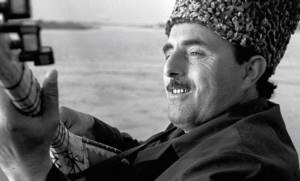
National flavor can always be seen in the art of dance. If we consider the folk dance of Azerbaijanis, we cannot help but note its unique rhythmicity. They can be either overtly rhythmic or smooth.
It is on strict adherence to rhythm that the entire pattern of the dance, its structure, is built. Those dances that have roots in ancient traditions often bear the names of plants or animals characteristic of Azerbaijan. There are many videos of them performing their dances passionately.
Speaking about the national costumes of Azerbaijanis, it is necessary to mention their correlation with the cultural and geographical location of the region itself. Men wear a caftan-arkhalyg, and under it they put on an undershirt. A man's suit also includes outerwear for cold weather - after all, in the foothills of the Caucasus in winter, only a burka or a fur coat made of tanned lamb skins can save you.

If you look at the photos of Azerbaijanis, you can see that they often wear a Circassian coat with gazyrs. The women's costume is no less bright and original. These are the top and bottom dresses, as well as the obligatory veil. A mandatory component of women's clothing has always been a belt or sash - such belts could be richly decorated with gold and embroidery, which could say a lot about the status of a woman.
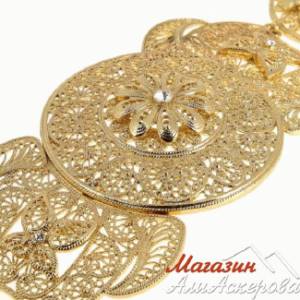
Another custom concerning the appearance of women is the traditional coloring of hair and nails with henna. Henna dyeing is also a legacy of the influence of Persian culture.
Traditions and customs after the wedding celebration
There are many rituals and traditions after a wedding in Azerbaijan. For example, relatives on both sides have the right to look at the sheet after the first wedding night in order to make sure of the purity and innocence of the betrothed. After performing the ritual, the hosts should treat the guests to pilaf. After the wedding, the duties of the mother-in-law include presenting various treats to the newlyweds for 3 days.
After the wedding, the bride is not allowed to see her father-in-law for two weeks, after which the mother-in-law sets the festive table, and the father-in-law calls the bride and gives her a personal gift. This ritual symbolizes the acceptance of the daughter-in-law into the new family by the older generation of the husband.
After a certain number of months, the young mother has the right to visit her daughter’s new family with her relatives. The first meeting with parents is unique in its own way. After 40 days from the date of the celebration, the newlyweds have the opportunity to personally visit the bride’s family. The parents of the newly-made bride must set the table, and she herself can, if she wishes, stay for a few days in the old house.
After the completion of the rituals, the time restriction is lifted and the girl can visit her family whenever she wants. Often, relatives of both parties invite the newlyweds to visit to exchange experiences and gifts. Modern traditions provide for the possibility of photographs with the bride and groom, and also allow the newlyweds to sit at the table with the invited guests.
An Azerbaijani wedding is a unique event, the presence of which will help you understand the ancient traditions and rituals of this unique culture.



